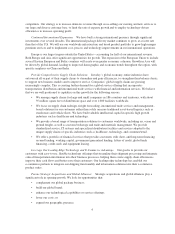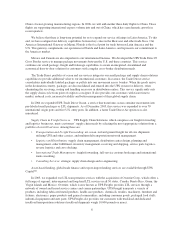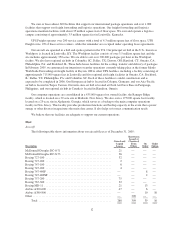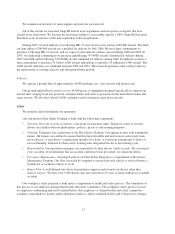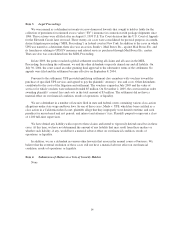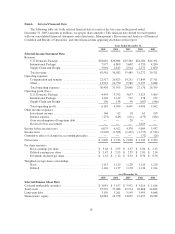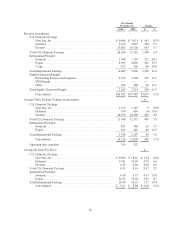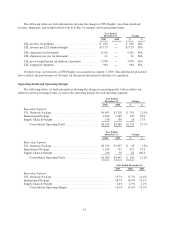UPS 2005 Annual Report Download - page 24
Download and view the complete annual report
Please find page 24 of the 2005 UPS annual report below. You can navigate through the pages in the report by either clicking on the pages listed below, or by using the keyword search tool below to find specific information within the annual report.We believe one increasingly important element of competition is a carrier’s ability to integrate its
distribution and information systems with its customers’ systems to provide transportation solutions at
competitive prices. We rely on our vast infrastructure and service portfolio to attract and maintain customers. As
we expand our supply chain solutions service offerings, we compete with a number of participants in the supply
chain, financial services and information technology industries.
Government Regulation
The U.S. Department of Homeland Security, through the Transportation Security Administration (“TSA”),
the U.S. Department of Transportation (“DOT”) and the Federal Aviation Administration (“FAA”), regulates air
transportation services.
The TSA regulates various security aspects of air cargo transportation in a manner consistent with the TSA
mission statement to “protect[s] the Nation’s transportation systems to ensure freedom of movement for people
and commerce.”
The DOT’s authority primarily relates to economic aspects of air transportation, such as discriminatory
pricing, non-competitive practices, interlocking relations and cooperative agreements. The DOT also regulates,
subject to the authority of the President of the United States, international routes, fares, rates and practices, and is
authorized to investigate and take action against discriminatory treatment of U.S. air carriers abroad. We are
subject to U.S. customs laws and related DOT regulations regarding the import and export of shipments to and
from the U.S. In addition, our customs brokerage entities are subject to those same laws and regulations as they
relate to the filing of documents on behalf of client importers and exporters.
The FAA’s authority primarily relates to safety aspects of air transportation, including aircraft standards and
maintenance, personnel and ground facilities. In 1988, the FAA granted us an operating certificate, which
remains in effect so long as we meet the operational requirements of federal aviation regulations.
FAA regulations mandate an aircraft corrosion control program, and aircraft inspection and repair at
periodic intervals specified by approved programs and procedures, for all aircraft. Our total expenditures under
these programs for 2005 were $14 million. The future cost of repairs pursuant to these programs may fluctuate.
All mandated repairs have been completed, or are scheduled to be completed, within the timeframes specified by
the FAA.
Our ground transportation of packages in the U.S. is subject to the DOT’s jurisdiction with respect to the
regulation of routes and to both the DOT’s and the states’ jurisdiction with respect to the regulation of safety,
insurance and hazardous materials.
We are subject to similar regulation in many non-U.S. jurisdictions. In addition, we are subject to non-U.S.
government regulation of aviation rights to and beyond non-U.S. jurisdictions, and non-U.S. customs regulation.
The Postal Reorganization Act of 1970 created the U.S. Postal Service as an independent establishment of
the executive branch of the federal government, and vested the power to recommend domestic postal rates in a
regulatory body, the Postal Rate Commission. We participate in the proceedings before the Postal Rate
Commission in an attempt to secure fair postal rates for competitive services.
We are subject to numerous other laws and regulations in connection with our non-package businesses,
including customs regulations, Food and Drug Administration regulation of our transportation of pharmaceuticals
and state and federal lending regulations.
Where You Can Find More Information
We make our annual reports on Form 10-K, quarterly reports on Form 10-Q, current reports on Form 8-K, and
all amendments to these reports available free of charge through the investor relations page of our website, located
at www.shareholder.com/ups, as soon as reasonably practicable after they are filed with or furnished to the SEC.
9







